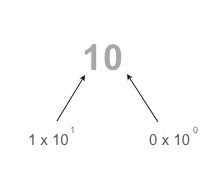The first thing we learned yesterday was an easier way to find z scores.
1. Go to stat then edit.
2. Then go to L1 and push in the list of numbers.
3. Go to L2 and at the top push in (L1-mean)/the standard deviation.
4. Now you have your z scores :)
We also learnt about Normal distribution 
Above is a picture of normal distribution. Notice how it has a bell shape, this will help you indentify normal distribution in a graph. Most of the data in normal distribution is continuous (has decimal places). There are certain properties of normal distribution which are...
1. 68% of data lies within 1 standard deviation of the mean.
2. 95% of data lies within 2 standadrd deviations of the mean.
3. 99.7% of data lies within 3 standard deviation of the mean.
There are other facts about normal distribution. The area under the curve equals one. The x axis is an asymptote for the curve (the line goes close but never hits zero). Tha graph is symetrical. as well the farther away you go out the less data there is.
Another thing we talked about in class is how to find the mean with the z score. To do this you have to follow the formula (z score * standard devation)+ mean
Next is Daniel
Answer Tips
Create Math Images
Labels
- Alvina (6)
- am40sw09 (8)
- Amanda (4)
- Camilla (5)
- Carmel (3)
- Chelsea (6)
- Class Survey (1)
- Compound Interest (2)
- Copyright (1)
- Daniel (5)
- David-san (1)
- Design and Measurement (2)
- Developing Expert Voices (16)
- Digital Ethics (1)
- Don (6)
- Dr. Eviatar (4)
- Eugene (5)
- First Post (1)
- Glenn (5)
- Henson (4)
- Homework (6)
- Iris (5)
- Jason (6)
- K_Hannah (5)
- Kathrine (2)
- Kayla (5)
- Kyle (6)
- Lamael (4)
- MAC (4)
- Matrices (22)
- Model Problems (2)
- Mr. Kuropatwa (69)
- Niwatori-san (4)
- Periodic Functions (6)
- Personal Finance (16)
- Pi Day (1)
- Post (1)
- Probability (33)
- Reflection (17)
- Scribe Post (57)
- Sequences (7)
- Sine Function (1)
- Slides (67)
- Sribe Post (1)
- Statistics (35)
- Statistics Reflection (1)
- Time Line (13)
- Vector (1)
- Vectors (15)
Blog Archive
-
▼
2009
(166)
-
▼
March
(35)
- Sorry about the lateness
- Today's Slides: March 27
- Niwatori's Corner (Statistics - Zscores!)
- Niwatori's Corner (Statistics - Looking for patterns)
- Today's Slides: March 25
- Today's Slides: March 24
- MAN AM I TIRED.
- Today's Slides: March 23
- Introduction to Statistics
- Today's Slides: March 20
- Today during class we did our "Pre-test" for our c...
- Today's Slides: March 18
- Hi everybody, just a heads up there is a pre-test ...
- Today's Slides: March 17
- Today's Slides: March 16
- Today in class Mr. K started off by putting us int...
- Today's Slides: March 13
- Happy Pi Day!
- Today in class Mr.K started off by putting us into...
- Today's Slides: March 12
- Today in class we started off being broken down in...
- Today's Slides: March 11
- Today's Slides: March 10
- Hello There !Today Mr. K started off with putting ...
- Today we started off with talking about PI DAY. We...
- Today's Slides: March 9
- Counting
- Today's Slides: March 6
- The Fundamental Principle of Counting
- Today's Slides: March 5
- Scribe Post for March 2nd
- PROBABILITY
- Today's Slides: March 4
- Today's Slides: March 3
- Today's Slides: March 2
-
▼
March
(35)
Saturday, March 28, 2009
Sorry about the lateness
Posted by
iamamanda
at
3:41 PM
1 comments
![]()
![]()
Labels: Amanda, Scribe Post, Statistics
Friday, March 27, 2009
Today's Slides: March 27
Here they are ...
Posted by
Darren Kuropatwa
at
2:48 PM
0
comments
![]()
![]()
Labels: Mr. Kuropatwa, Slides, Statistics
Thursday, March 26, 2009
Niwatori's Corner (Statistics - Zscores!)
KONICHIWA MINA!
Welcome back to Niwatori-san's corner and today is Z-scores. Feed the need for more MATH!
For Your Information. . . . Red Anecdotes Stuff to know/IMPORTANT STUFF but take it however you will
Blue Anecdotes kinda important so like review it if you like
Green is for formulas/calculations with the calculator and so forth
After the briefing of when a standard deviation is 1,2,3 or even 4 deviations above or below the mean... might as well tell you what "above/below standard deviations from the mean" means.
**In short, you have the mean of a set of data and then a standard deviation from the data the whole basis is when you are "below" the mean you subtract the number of standard deviations from the mean getting a negative number. Being "above the mean" just means to add the number of standard deviations to the mean.
The formula for this is: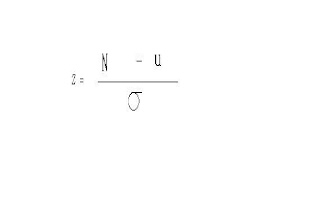 When you need to get a Z-score to determine which side is greater than the other you get the Z-scores of all the needed info. Then you compare with which number is greater.
When you need to get a Z-score to determine which side is greater than the other you get the Z-scores of all the needed info. Then you compare with which number is greater.
Sorry but I couldn't think of an example right at the moment but look over the slides MR.Kuros posted up.
Look look the thing is for now is to use this formula for the distribution tables and follow along with the lessons to come.
Sorry that this post is short but that's all I can think of with my Knowledge for now.
(Plus it's just a review of what we did anyways so meh sue me >-<)
Anywho.. . . . David-san is the next Scriber! (>_<>
"Eagerness brings the most out of Enthusiasm!"
Posted by
Niwatori-san
at
7:42 AM
0
comments
![]()
![]()
Labels: Niwatori-san, Scribe Post, Statistics
Wednesday, March 25, 2009
Niwatori's Corner (Statistics - Looking for patterns)
O hayao gozaimasu mina! (forgot what this means it means "Hello everyone in formal context =p)
!!!!For Ya Imfomation. . . . . . !!!!!!
Blue anecdotes sorta inportant
Red anecdotes Stuff to check/IMPORTANT STUFF take it however you will
Green is for formulas/any calculator stuff!
Anywho. . . today I will serve you with both the Looking for patterns in Statistics "Grouped data" as well as how to get these Z-scores but keep yourself tuned for the next posting for the Z-scores part =p
Yes, well just to quote Mr.Kuros and his masterful words of math ( = [ apparently flattery doesn't get free marks) "Math is the Science of Patterns" it really is. You are looking for simliar patterns and then apply them to what we are given to us. Basically saying, having things you know and utilize the ideas/patterns to solve something new unknown to us.
Ok? Ok! >_<
Remember hearing about the difference between "S" and "O" Standard Deviations?
Well here's the thing "S" is for a sample of a large data in which for the learning process of Statistics we're only using "o" in this case the sign "SIGMA" anecdotes for "sum of" to find the neccessary info which is the population
an example is a survey of favorite car around the world where 1000 people out of 40000 people in the country take the survey and then taking that info to predict everyone elses choice of car. This is considered the "S" type being that this is a large piece of data.
"o" type for example is the survey given to Sisler High School and then seeing who likes which car. A small population such as a local school is considered "o" type where data is small.
Ok now?
Now on with Niwatori-san's Diagrams
--follow them and ask for questions like comments/or at school ask for some help you all know who Niwatori-san is =P--
-See now we were taught the day before of something called a "Frequency distribution table"
as well as a "Probability distribution table" actually the probablity one is just the figures/numbers in percentages! So these diagrams will review my knowledge of how to crack at this shell in a nutshell! -
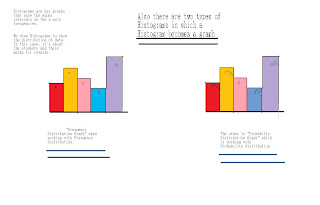
The above diagram shows a Histogram and this bar graph will be your friend.
To build one go to (STAT PLOT) on the (Y=) button but press the (2nd) button 1st from that press the 1st one for now. After this Highlight and press the ON side. The x-value will always be L1, the frequency will be different depending if your working with a probability/frenquency graph. --HINT-- L3 for probability most of the time L2 for the frequency most of the time trust me you`ll understand when you press them!
Well that concludes this portion. Wait till morning for the next page. I needed to rest sorry folks.
Anyways the next scriber is David-san!
*Passes baton skoots away pwoosh pwoosh pwoosh*
"My hope is today is tommorrow`s colorful"
-By Niwatori-san-
Posted by
Niwatori-san
at
9:05 PM
0
comments
![]()
![]()
Labels: Niwatori-san, Scribe Post, Statistics
Today's Slides: March 25
Here they are ...
Posted by
Darren Kuropatwa
at
12:50 PM
0
comments
![]()
![]()
Labels: Mr. Kuropatwa, Slides, Statistics
Tuesday, March 24, 2009
Today's Slides: March 24
Here they are ...
Posted by
Darren Kuropatwa
at
1:41 PM
0
comments
![]()
![]()
Labels: Mr. Kuropatwa, Slides, Statistics
Monday, March 23, 2009
MAN AM I TIRED.
Alright childrens, here's some things you should consider.
Posted by
Daniel
at
11:45 PM
1 comments
![]()
![]()
Labels: Daniel, Scribe Post, Statistics
Today's Slides: March 23
Here they are ...
Posted by
Darren Kuropatwa
at
12:55 PM
0
comments
![]()
![]()
Labels: Mr. Kuropatwa, Slides, Statistics
Friday, March 20, 2009
Introduction to Statistics
Today in class we started our Statistics unit. We started the class going over some ideas (found on the first couple slides) to start thinking about why and how statistics is used. Then we got into vocabulary. The terms are important and can be found on the 6th slide. There are also other notes following this and we also have a few homework questions. Mr. K stressed that this unit can be difficult and it is IMPORTANT to stop him and ask questions as soon as something is unclear. We spent a lot of time on Measures of Central Tendency and Dispersion today.
Measures of Central Tendency: Mean, Median, and Mode:
Mean: The mean can be found by adding up all of the quantities given and dividing that sum by the number of quantities that were adde
 d. The equation for calculating the mean is:
d. The equation for calculating the mean is:Where "x bar" represents the mean,
"N" represents the total number of quantities (if you added five numbers together this N would equal 5,
 X means the sum of all data
X means the sum of all dataFor ex. If you had the numbers 17 11 23 6 and 3.
To find the mean add up all the numbers:
17+11+23+6+3=60.
Next divide the sum (60) by the number of quantities that were added.
60/5
The answer would be: 12
Median: The median is the middle number in a given set of numbers. If the total number of numbers is even then the median is found by adding the two middle numbers and dividing by two. For example. If you had the numbers 17 11 23 6 and 3
The median would be found by first sorting the numbers from smallest to biggest
3 6 11 17 23
Next you would find the number in the middle:
11 If the set of numbers was 3 6 11 17 23 and 30
You would need to take the two middle numbers and add them then divide by two.
(11+17)/2
The answer would be 14.
Mode: The mode is the number that occurs most often in a set of data. When there are two numbers that show up an equal number of times it is termed Bimodal Distribution. *NOTE: When used in class distribution refers to "a bunch of data".
For example: If you had the numbers 8 14 14 20 and 24
The mean would be 14.
If the numbers were 8 14 14 20 20 24
The answer would be 14 and 24
Click here for practice problems
Measures of Dispersion: Range and Standard Deviation:
Range: The range is the difference between the smallest and largest values in a data set. The only values that matter when calculating the range are the highest and lowest numbers!
For example if you had the numbers: 5 10 15 20 and 25
Locate your highest number: 25
lowest number: 5
And subtract: 20
Standard Deviation: In standard deviation all the numbers in a data set 'matter'. It is a measure that shows how the data is dispersed in reference to the mean.
The symbol for Standard Deviation is

Calculator:
Mr. K also went over in class how to use our calculators for some of the calculations we will be learning this unit.
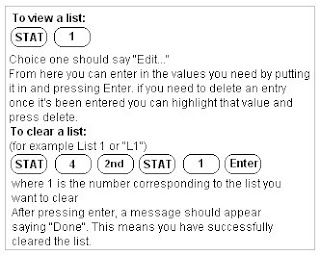
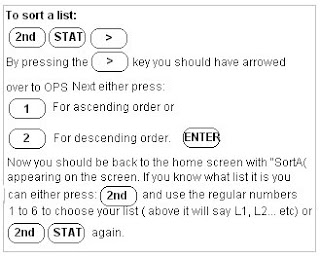

Next Scribe is Daniel
Posted by
Kayla
at
6:36 PM
0
comments
![]()
![]()
Labels: Kayla, Scribe Post, Statistics
Today's Slides: March 20
Here they are ...
Posted by
Darren Kuropatwa
at
2:56 PM
0
comments
![]()
![]()
Labels: Mr. Kuropatwa, Slides, Statistics
Wednesday, March 18, 2009
Today during class we did our "Pre-test" for our current unit of probability. The pre-test prepares us for our upcomming unit test which takes place tomorrow March 19. The format of our pre-test was 2 multiple choice questions, 2 short answer questions, and 1 3-step problem. We were given about 35-40 minutes to write our pre-test and after that Mr. K split us up into groups to compare answers. After about ten minutes of comparing answers, Mr. K went over the questions and showed us step by step how it came out to the answer.
In my group there were a couple a questions that stumpted my group members and I, but now I understand why and how we got the answer.
Here is one question that we didn't quite get right..
Using the word FOOD, find the probability that an arrangement of this word will begin with the two O's if all the letters are used. Correct to the nearest hundreth.
So to start off, you need to make sure that the two O's are stuck together at the front of the four letter combination. A way that Mr. K would refer it to would be "take the two O's and put them in a bag."
And this is what the 4 letter word combination can look like..
The first 1 stands for the 2 O's which are "stuck together," they are first because the question requires for them to be at the front of the four letter combination. The 2 stands for the choice of either F or D. And the last 1 stands for the left over of the previous two. (Say I choose F for the second space, then the last space would be a D and vice versa.)
So now you are required to multiply 1 by 2 by 1 in order to find out the number of ways for the combination. The answer is 2.
Now you take the the amount of ways that the four letter word can be rearranged(2 differnt ways) and you divide it by 4 factorial(representing the total number of letters) divided by 2 factorial(representing the 2 O's)
You would do it like so..
The result would be 2/12 then would reduce into 1/6, and because the question says around to the nearest hundreth, you must express the faction into a decimal which is 0.17.
* JUST A REMINDER * our unit test is tomorrow!
For further review Mr. K posted up extra questions.
I choose Kayla for the next scribe!
Posted by
iris
at
8:54 PM
0
comments
![]()
![]()
Labels: Iris, Probability, Scribe Post
Today's Slides: March 18
Here they are ...
Posted by
Darren Kuropatwa
at
3:57 PM
0
comments
![]()
![]()
Labels: Mr. Kuropatwa, Probability, Slides
Tuesday, March 17, 2009
Hi everybody, just a heads up there is a pre-test tomorrow so be prepared.
Any who today in class we learned two new topics. These topics are called Mutually exclusive and Non Mutually exclusive events. The way something can be mutually exclusive is if it is impossible for them to occur together. Basically like saying you can't be the age 31 and at the same time be 16, there is just no way. Or like saying can you roll a die and get both a positive and negative number at the same time.
Examples
Drawing one card either, a black ace or a red two
When randomly selecting two animals from a barn either a, cat or dog
Randomly selecting a person either a, girl or a boy
Now non mutually exclusive events are the exact opposites when things can happen together, like either drawing from a deck of cards a king or a spade. You can actually draw a king of spades.
Examples
Selecting a person for your basketball team who is either, fast or tall
Sleeping with either a, long pillow or comfy pillow
Rolling a two dice and either getting a sum of an odd number or a double
Although you may just think of this as the exact opposite to mutually exclusive events there is more thinking involved. Mutually exclusive event formula is (A) n (B) = zero set, done. For non mutually exclusive events there is a big formula you have to follow.
Using Mr.K's example I will explain
You wish to draw either a king or a spade from a single deck
A represents kings
B represents spades
Now remember one card is both keep this in mind
So the formula looks like this P ( A U B ) = P(A) + P(B) - P(AnB)
Plug in the numbers and you it looks like
P ( A U B ) = 4/52 + 13/52 - 1/52
= 1/16
WHOA, why did we subtract the 1/52 people may ask, reason being because the card gets counted so we want to subtracted it so that it doesn't get counted twice.
So that is what we learned in class what I recommend doing is try to make up your own mutually and non mutually exclusive events and practise further with the formula. Now the next scribe I choose is IRIS......
Posted by
henson
at
11:19 PM
1 comments
![]()
![]()
Labels: Henson, Probability, Scribe Post
Today's Slides: March 17
Here they are ...
Posted by
Darren Kuropatwa
at
12:45 PM
0
comments
![]()
![]()
Labels: Mr. Kuropatwa, Probability, Slides
Monday, March 16, 2009
Today's Slides: March 16
Here they are ...
Posted by
Darren Kuropatwa
at
2:38 PM
0
comments
![]()
![]()
Labels: Mr. Kuropatwa, Probability, Slides
Sunday, March 15, 2009
Today in class Mr. K started off by putting us into groups. We were then given problems to solve. You can check the slide for today.
Independent and Dependent event
My understanding about Dependent Variable it's called dependent variable because it's distribution of values depends upon the distribution of the other values or in other words It is something that depends on other factors while Independent Variable is a variable whose value determines the value of other variables or it is a variable that stands alone and isn't changed by other variable.
Here are some examples
The two events do not affect each other because it is an Independent event.
Two balls are drawn successively without replacement from a box which contains 4 blue balls and 3 red balls.
Find the probability that:
(a) the first ball drawn is blue and the second is red
(b) both balls are red.
P(blue) = 4/7
There are 6 balls left and out of those 6, three of them are red. So the probability that the second one is red is given by:
P(red) = 3/6 = 1/2 reminder always simplify
dependent event so 4/7 × 1/2 = 2/7
Also dependent event. Using same method, but realizing there will be 2 red balls on the second draw, we have:

The next scriber I choose is : HENSON
Posted by
MAC
at
12:09 PM
0
comments
![]()
![]()
Labels: MAC, Probability, Scribe Post
Friday, March 13, 2009
Today's Slides: March 13
Here they are ...
Posted by
Darren Kuropatwa
at
12:26 PM
0
comments
![]()
![]()
Labels: Mr. Kuropatwa, Pi Day, Probability, Slides
Happy Pi Day!

Wishing you the best of Pi Days!!!
Did you know that the U.S. House of Representatives even passed a resolution calling for March 14 to be recognized as "National Pi Day in the United States? You can read about it here.
Photo Credit
Posted by
Anonymous
at
11:55 AM
0
comments
![]()
![]()
Thursday, March 12, 2009
Today in class Mr.K started off by putting us into groups. We went over the homework that was assigned to us the night before. The answers to the questions are posted on todays slides, March 12th.
The new lesson we learned today was COMBINATIONS ( the "choose" formula). The formula is as follows:
"n" is the number of objects availabl to be arranged
"r" is the number of objects tht are being arranged
EXAMPLES:
You would read this as 10 "choose" 5 equals 10 divided by 5 factorial multiplied by 5 factorial.
By choosing 5 people to make a team which equals 5!, that means there is remainder of 5 other people from the 10.
The answer to this question is : 252
Posted by
don
at
9:05 PM
0
comments
![]()
![]()
Labels: Don, Probability, Scribe Post
Today's Slides: March 12
Here they are ...
Posted by
Darren Kuropatwa
at
4:35 PM
0
comments
![]()
![]()
Labels: Mr. Kuropatwa, Probability, Slides
Wednesday, March 11, 2009
Today in class we started off being broken down into groups. We then quickly checked our homework. We were then given a problem to solve, it's on the slides today March 11, slide 9.
The question was:
Suppose that, when you go home from school, you like to take as great a variety of routes as possible, and that you are equally likely to take any possible route. You will walk only east or south.
We used the Pascal's Triangle to solve how many ways we can get from School to home. The answer was 180 ways to get from School to Home.
This is how it was done:
Then we went into more depth of the question, Daniel went up and explained that there was really only a certain way to go home AND pass the post office. This is what he means. The red lines shows how many ways you can pass the post office, from school to home. The blue just shows the extra routes going from school to home, WITHOUT passing through the post office.
So now getting back to the question which was, what is the probability of passing the post office on your way home.
The answer would be:
Number of ways from School to Home passing the post office: 72
Over the total number of ways from School to Home: 180
SO: 72 / 180 would be the probability of passing through the post office on your way home!
Reminder, always reduce fractions if possible!
Reduced fraction = 2 / 5
And the next scribe would be..
DON !
Posted by
Kyle
at
9:38 PM
0
comments
![]()
![]()
Labels: Kyle, Probability, Scribe Post
Today's Slides: March 11
Here they are ...
Posted by
Darren Kuropatwa
at
12:47 PM
0
comments
![]()
![]()
Labels: Mr. Kuropatwa, Probability, Slides
Tuesday, March 10, 2009
Today's Slides: March 10
Here they are ...
Posted by
Darren Kuropatwa
at
4:30 PM
0
comments
![]()
![]()
Labels: Mr. Kuropatwa, Probability, Slides
Examples:
Book
Since there are 4 letters and 2 letters that are the same the equation would be 4!/2! = 12
Mississippi
Since there are 11 letters and 4S's, 4I's, 2P's, the equation would be 11!/(4!*4!*2!) = 34650.
Non distinguishable object is an easier way of solving problems. We didnt really get to look into it a lot so Mr. K said we would do some more tomorrow !
The next scriber would be....
KYLE ! =)
Posted by
kathrine
at
12:30 PM
0
comments
![]()
![]()
Labels: Kathrine, Probability, Scribe Post
Monday, March 9, 2009
Today we started off with talking about PI DAY. We get to party this Friday & eat PIE! Not only are we going to eat pie but we get to share math jokes. So everyone don't forget to bring pie along with a stupid math joke.
Our lesson for today was Permutations (the 'Pick' Formula). A permutation is an ordered arrangement of objects. n - # of objects available to be arranged
n - # of objects available to be arranged
r - # of objects that are being arranged Factorial notation is really an easier way of multiplying all the natural numbers from a particular number down to 1.
Factorial notation is really an easier way of multiplying all the natural numbers from a particular number down to 1.
We went over our homework as well which are posted on the blog.
Kathrine already knows she's the next scriber.
Posted by
Camilla
at
5:50 PM
0
comments
![]()
![]()
Labels: Camilla, Probability, Scribe Post
Today's Slides: March 9
Here they are ...
Posted by
Darren Kuropatwa
at
12:31 PM
0
comments
![]()
![]()
Labels: Mr. Kuropatwa, Probability, Slides
Friday, March 6, 2009
Counting
Hello everyone! For today's class we started off with Mr. K teaching us how to count in bases.
Posted by
alvina
at
8:37 PM
0
comments
![]()
![]()
Labels: Alvina, Probability, Scribe Post
Today's Slides: March 6
Here they are ...
Posted by
Darren Kuropatwa
at
3:09 PM
0
comments
![]()
![]()
Labels: Mr. Kuropatwa, Probability, Slides
Thursday, March 5, 2009
The Fundamental Principle of Counting
Overview of Today
We started off today's class taking a quick look at the blog and then discussed the Bento picture (The first Slide for today). We discussed different ways to arrange the three vegetables in the yellow dish (came to the conclusion it was six). After that we reviewed the homework for last night, and moved on to The Fundamental Principle of Counting.
The Fundamental Principle of Counting
The Fundamental Principle of Counting states: If there are M ways to do a first thing and N ways to do a second thing then there are M x N ways to do both things (found on slide 7).
For Example:
You need to run your weekly errands and need to make a stop at a mall, a grocery store and a hardware store. In your area there are two malls, three grocery stores and two hardware stores approximately the same distance from your house. How many different possible routes are there that include stopping at one of each store.
First pick out the given information:
2 Malls
3 Grocery Stores
2 Hardware stores
Then multiply:
2 Malls x 3 Grocery Stores x 2 Hardware Stores
=12 Different Routes
For more practice:
http://regentsprep.org/regents/Math/counting/praccnt.htm
This site contains simple questions and explanations.
Important Things to Know:
Today there was not a great number of people who completed their homework and Mr. K was not thrilled. He has implemented Homework Quizzes. Mr. K will be checking our homework from a past date so it is important that we date our work as well as label the questions properly. The quiz will just be to hand in the question when it is asked.
There are a couple homework questions at the end of the slides.
Tomorrows scribe will be Alvina :)
Posted by
Kayla
at
4:42 PM
0
comments
![]()
![]()
Labels: Kayla, Probability, Scribe Post
Today's Slides: March 5
Here they are ...
Posted by
Darren Kuropatwa
at
1:01 PM
0
comments
![]()
![]()
Labels: Mr. Kuropatwa, Probability, Slides
Chatbox
Contributors
Links
Recent Comments

This work is licensed under a Creative Commons Attribution-Noncommercial-Share Alike 2.5 Canada License.



